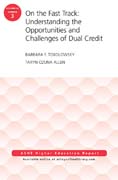
On the Fast Track: Understanding the Opportunities and Challenges of Dual Credit, AEHE 42:3
Tobolowsky, Barbara F.
Allen, Taryn Ozuna
The dual–credit curricular initiative offers high school students the opportunity to earn college and high school credits simultaneously without taking a standardized test to acquire the credit. The courses are purported to introduce students to a more rigorous curriculum in high school and save them time and money in their pursuit of college degrees. Dual credit programs have grown rapidly, and this monograph provides a synthesis of: the scholarly literature on dual credit offered at high school and a variety of postsecondary settings; underrepresented students experiences with the course(s), and suggestions for future research and drivers that will influence its development. Originally, these initiatives focused on high–achieving students, but additional models have emerged that expand the benefits to lower– and middle–achieving students as well. This is the third issue of the 42nd volume of the Jossey–Bass series ASHE Higher Education Report. Each monograph is the definitive analysis of a tough higher education issue, based on thorough research of pertinent literature and institutional experiences. Topics are identified by a national survey. Noted practitioners and scholars are then commissioned to write the reports, with experts providing critical reviews of each manuscript before publication. INDICE: Executive Summary 7 .Foreword 12 .Introduction to Dual Credit 14 .Purpose of the Book 16 .Precollege Curricular Options 17 .Distinguishing Dual Credit 21 .Structure of the Book 29 .Postsecondary Institutions as a Gateway to Dual Credit 31 .Location for Dual Credit Instruction 33 .Course Offerings 35 .Student Participation 36 .Instructor Eligibility 39 .Funding Dual Credit Programs 40 .Course Costs 41 .Benefits and Challenges 42 .Conclusion 45 .Dual Credit in High School Settings 46 .Traditional High Schools 46 .Middle College High Schools 51 .Early College High Schools 56 .Conclusion 61 .The Students Experiences in Dual Credit 62 .High–, Middle–, and Lower Achieving Students 63 .Traditionally Underrepresented Student Populations 69 .Gender Differences 77 .Dual Credits After Matriculation 79 .Conclusion 80 .Summary and Implications for the Future 81 .Recommendations for Research 82 .Future Considerations for Dual Credit 86 .Conclusion 89 .Notes 90 .References 92 .Name Index 107 .Subject Index 112 .About the Author 115
- ISBN: 978-1-119-27540-4
- Editorial: Jossey Bass
- Encuadernacion: Rústica
- Páginas: 120
- Fecha Publicación: 04/05/2016
- Nº Volúmenes: 1
- Idioma: Inglés
